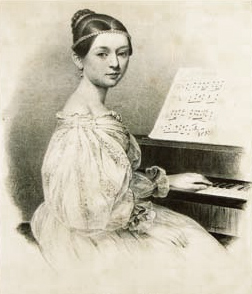
Music Period: Romantic era (1830 – 1900)
Location: Leipzig, Germany
Claim to Fame: One of the foremost pianists and greatest performers of the nineteenth century.
Clara Schumann was part of what has been described as the “greatest musical love story of the nineteenth century”. The musical partnership that developed with her husband would last twenty-six years. They shared musical ideas and sometimes quoted one another in their works. Yet, Clara faced many obstacles throughout her career and constantly battled against social ideals about women. It is perhaps because of these restrictions that the memory of her as a composer and one of the greatest performers of the nineteenth century, has faded away.
Clara was born in September 1819 to Marianne and Friedrick Wieck. When she was just four and a half years old, her mother left her husband, and Clara lived her father from the age of five. Fredrick became father, teacher, and manager to Clara from that moment on. When she was just seven years old, he started a diary for her, and set the stage for a tradition that would continue until Clara was nineteen. The diary was maintained for the most part by Fredrick himself who either wrote entries himself, or supervised the entries written into the diary. It seems clear, then, that Fredrick controlled all aspects of Clara’s life from an early age.
For the first four years of her life, Clara was thought to be deaf, and her father worked hard to transform her into the “prodigy of prodigies” (Sounds and Sweet Airs, 2016). Friedrick had big ambitions to mould his daughter into the highest-ranking performing artist. This came at a time when female concert pianists were rare and society stood firm on the ideal that women should fulfil their duties at home. Friedrick did not let this stop him. He started a formal musical education programme early on and taught Clara to play the piano. At just 5 years old, this bright little girl could play by ear and was encouraged to transpose little pieces, as well as improvise her own themes. All this came before she was even able to read music. It was only when Clara was 10 years old that she started to receive formal harmony counterpoint and composition lessons. These worked alongside her singing and violin lessons where she learned score reading. To ensure the best musical education, Clara went on to study advanced composition and orchestration. Friedrick also ensured to teach his daughter about life as a professional musician and the music business alongside this – something that come in handy later on in life.
Clara played her first official Leipzig Gewandhaus concert at the age of nine. The audiences loved her and her father lost no time in arranging a tour for her. By 1835, Clara became famous all over Europe for her astounding musical talent. It was customary at this time for performers to play their own compositions in concerts. Clara soon introduced her own works to her programmes in response. This led to her publishing her first work in February 1831. Quatre Polonaises was designed to show off her pianist skills. It displays Clara‚Äôs gift for harmonic surprise and boldness with adventurous modulations. Then, in November 1835, the music world was introduced to her Piano Concerto Opus.7. It is a dramatic and innovative work that was premiered in a performance at the Leipzig Gewandhaus directed by Felix Mendelssohn. Clara was just fifteen years old at the time and already she had achieved something great for any composer ‚Äì not to mention a woman who wasn’t supposed to perform in public.
-Claire Amundson
Junior Girl
Girl Museum Inc.
